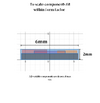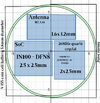Project Overview:
ultra-compact microlocator device that can be attached to items like glasses and located using a phone app. Key requirements:
Form factor under 2mm thick and 6mm diameter
Long battery life
BLE 5.3 for connectivity and location
Components:
IN100 Bluetooth SoC (InPlay Technologies)
DFN8 (2.5x2.5mm) package
BLE 5.3
Ultra-low power, less than 10nA lost in sleep mode
V335 Coin Cell Battery
1.2mm thick, 5.8mm diameter
Should enable multi-year battery life
26MHz Crystal
Required for IN100's RF operation
Small 2.0x2.5mm package
Antenna
WLA.01
Required for IN100's RF operation
Small 1.6x3.2mm
Question: Am I missing something? It seems as though this setup would work for sub-meter location first using RSSI data to get in the ball park and then AoA when close . I would love to have a rhinestone that I could glue to my glasses and never lose them!
ultra-compact microlocator device that can be attached to items like glasses and located using a phone app. Key requirements:
Form factor under 2mm thick and 6mm diameter
Long battery life
BLE 5.3 for connectivity and location
Components:
IN100 Bluetooth SoC (InPlay Technologies)
DFN8 (2.5x2.5mm) package
BLE 5.3
Ultra-low power, less than 10nA lost in sleep mode
V335 Coin Cell Battery
1.2mm thick, 5.8mm diameter
Should enable multi-year battery life
26MHz Crystal
Required for IN100's RF operation
Small 2.0x2.5mm package
Antenna
WLA.01
Required for IN100's RF operation
Small 1.6x3.2mm
Question: Am I missing something? It seems as though this setup would work for sub-meter location first using RSSI data to get in the ball park and then AoA when close . I would love to have a rhinestone that I could glue to my glasses and never lose them!
Attachments
Last edited:




